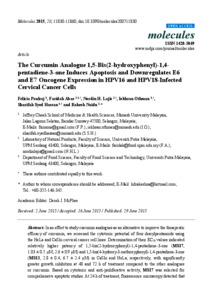Citation
Paulraj, Felicia and Abas, Faridah and Lajis, Nordin and Othman, Iekhsan and Syed Hassan, Sharifah and Naidu, Rakesh
(2015)
The curcumin analogue 1,5-bis(2-hydroxyphenyl)-1,4-pentadiene-3-one induces apoptosis and downregulates E6 and E7 oncogene expression in HPV16 and HPV18-infected cervical cancer cells.
Molecules, 20 (7).
pp. 11830-11860.
ISSN 1431-5157; ESSN: 1420-3049
Abstract
In an effort to study curcumin analogues as an alternative to improve the therapeutic efficacy of curcumin, we screened the cytotoxic potential of four diarylpentanoids using the HeLa and CaSki cervical cancer cell lines. Determination of their EC50 values indicated relatively higher potency of 1,5-bis(2-hydroxyphenyl)-1,4-pentadiene-3-one (MS17, 1.03 ± 0.5 μM; 2.6 ± 0.9 μM) and 1,5-bis(4-hydroxy-3-methoxyphenyl)-1,4-pentadiene-3-one (MS13, 2.8 ± 0.4; 6.7 ± 2.4 μM) in CaSki and HeLa, respectively, with significantly greater growth inhibition at 48 and 72 h of treatment compared to the other analogues or curcumin. Based on cytotoxic and anti-proliferative activity, MS17 was selected for comprehensive apoptotic studies. At 24 h of treatment, fluorescence microscopy detected that MS17-exposed cells exhibited significant morphological changes consistent with apoptosis, corroborated by an increase in nucleosomal enrichment due to DNA fragmentation in HeLa and CaSki cells and activation of caspase-3 activity in CaSki cells. Quantitative real-time PCR also detected significant down-regulation of HPV18- and HPV16-associated E6 and E7 oncogene expression following treatment. The overall data suggests that MS17 treatment has cytotoxic, anti-proliferative and apoptosis-inducing potential in HPV-positive cervical cancer cells. Furthermore, its role in down-regulation of HPV-associated oncogenes responsible for cancer progression merits further investigation into its chemotherapeutic role for cervical cancer
Download File
![[img]](http://psasir.upm.edu.my/46538/1.hassmallThumbnailVersion/The%20curcumin%20analogue%201%2C5-bis%282-hydroxyphenyl%29-1%2C4-pentadiene-3-one%20induces%20apoptosis%20and%20downregulates%20E6%20and%20E7%20oncogene%20expression%20in%20HPV16%20and%20HPV18-infected%20cervical%20cancer%20cells.pdf)  Preview |
|
Text
The curcumin analogue 1,5-bis(2-hydroxyphenyl)-1,4-pentadiene-3-one induces apoptosis and downregulates E6 and E7 oncogene expression in HPV16 and HPV18-infected cervical cancer cells.pdf
Download (2MB)
| Preview
|
|
Additional Metadata
Actions (login required)
 |
View Item |

